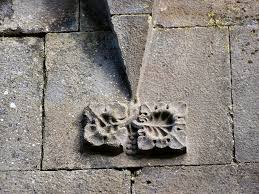Rosserk Abbey
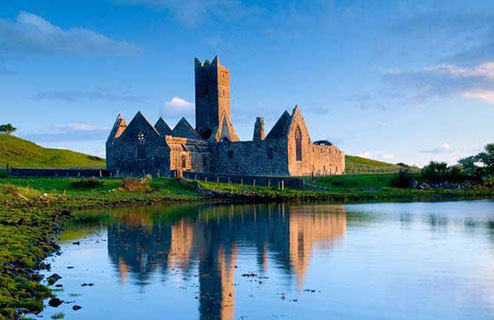
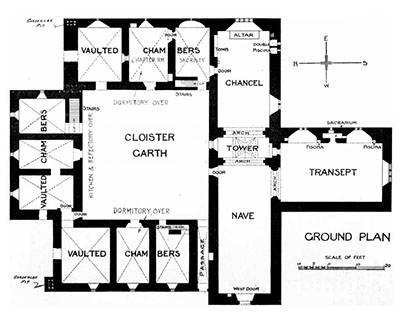
Myler de Bermingham/Birmingham, was the great grandson of Robert de Bermingham, a trusted comrade-in-arms of Richard de Clare, or ‘Strongbow,’ as this celebrated Norman knight is better known to the Irish.
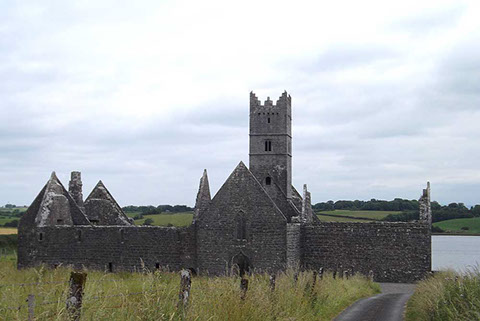 It is traditionally told, that for his military services in Ireland in the latter part of the twelfth century, Robert was given a substantial grant of land from King Henry 11 of England- the grant formed the area of modern county Offaly. A warrior-knight like his grandfather, Myler participated in the Anglo-Norman invasion of Connacht in the 1230s and afterwards founded a castle by the river Clarin, at a ford called Ath na Rí-‘the Ford of the Kings,’ now the county Galway town of Athenry. It is maintained that Connacht derived its name either from “Con,” one of the chief Druids of the Tua-de-Danans, or from Conn Ceadcatha –‘Conn of the Hundred Battles,’ Monarch of Ireland, in the second century, and of the line of Heremon, whose posterity possessed the country; the word iacht or iocht, signifying children or posterity, and hence “Coniacht,” the ancient name of Connacht, means the territory possessed by the posterity of Conn.
It is traditionally told, that for his military services in Ireland in the latter part of the twelfth century, Robert was given a substantial grant of land from King Henry 11 of England- the grant formed the area of modern county Offaly. A warrior-knight like his grandfather, Myler participated in the Anglo-Norman invasion of Connacht in the 1230s and afterwards founded a castle by the river Clarin, at a ford called Ath na Rí-‘the Ford of the Kings,’ now the county Galway town of Athenry. It is maintained that Connacht derived its name either from “Con,” one of the chief Druids of the Tua-de-Danans, or from Conn Ceadcatha –‘Conn of the Hundred Battles,’ Monarch of Ireland, in the second century, and of the line of Heremon, whose posterity possessed the country; the word iacht or iocht, signifying children or posterity, and hence “Coniacht,” the ancient name of Connacht, means the territory possessed by the posterity of Conn.
Recorded as being a great friend and supporter of the religious Dominican Order, ‘The Order of Preachers,’ Myler founded their house at Athenry, in 1241. Likewise, his son, William, Archbishop of Tuam (1289-1311), who despite having had several serious disputes with the Dominicans, always retained a high regard for the order, especially their founder, Dominic de Guzman, a native of Spain, whom he held in great esteem. In fact it is noted that he always included the name of St. Dominic when reciting the Confiteor and on the occasion of one provincial chapter, in honour of the saint, he made the friars a gift of a cask of fine Spanish wine.
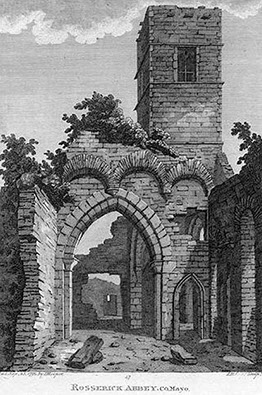 Myler’s daughter, Basilia, inherited the family tradition, and the records show that following her marriage to Stephen, Lord of Athleathan, son of Jordan of Exeter, she became disheartened when she discovered that the Exeters favoured the Franciscans over the Dominicans. Compounding her disappointment was the fact that a short time before her marriage, a Franciscan friary had been founded with the generosity of the Exeters, close by her new home at Straide, in present day, county Mayo. So, with time, her dislike for the Franciscans grew greater and she was determined to rid the region of the order. To achieve her aim she conceived a cunning plan.
Myler’s daughter, Basilia, inherited the family tradition, and the records show that following her marriage to Stephen, Lord of Athleathan, son of Jordan of Exeter, she became disheartened when she discovered that the Exeters favoured the Franciscans over the Dominicans. Compounding her disappointment was the fact that a short time before her marriage, a Franciscan friary had been founded with the generosity of the Exeters, close by her new home at Straide, in present day, county Mayo. So, with time, her dislike for the Franciscans grew greater and she was determined to rid the region of the order. To achieve her aim she conceived a cunning plan.
Basilica sent word to her powerful father inviting him to visit her at Straide. A sumptuous banquet was prepared in the great man’s honour and no sooner had the meal begun, than Basilia stood up and declared to all present that neither morsel nor drop would pass her lips until her husband, on trust, had granted her a special request . In the situation that he found himself, publicly compromised before the assembled elite, not to mention his notable warrior-knight father-in-law, her husband agreed. But what was Basilia’s request? She revealed to all that she desired her husband to expel the Franciscans from their friary at Straide and give the building and lands over to the Dominicans. Obliged to keep his word, her husband acquiesced. In the aftermath Basilia sent her agents to Rome ‘cum magna summa pecuniae’ to obtain a papal licence for the transfer. Unsurprisingly the licence was speedily granted and as a result, about the year 1252 or 1253, the first Franciscan connection with Mayo came to a sordid and tragic demise. It would be almost two hundred years before the Franciscans were allowed back to the region-to Rosserk.
“Rosserk was founded in the 15th century by a chieftain of the Joyces, a powerful family of Welsh extraction, remarkable (as they still are) for their gigantic stature, who settled in West Connaught in the thirteenth century.”
(Canice Mooney)
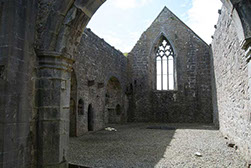 Writing in 1650, Dubhaltach MacFhirbisigh noted that “the McFirbises, poets of Tirawley, resided at Ros-Serce. This place is called Ros Serce from Searc, the daughter of Cairbre, Son of [King] Amhalgaidh, who blessed the baile (town) and the ros (promontory) which was situated at recte (near) the mouth of the river Moy. This Searc was a miracle-working saintess renowned for her benevolence and it was for her that the Reglus (an abbey or hermit’s cell) and Duirteach (small cell of prayer or penance-penitentiary) which are situated at the Ros (or in this Ros) were erected, i.e. Ros Erc.” Local tradition maintains that St. Patrick had a sister (religious) also named Searc, added to which, her father is the Cairbre referenced on the Breastagh Ogham Stone.
Writing in 1650, Dubhaltach MacFhirbisigh noted that “the McFirbises, poets of Tirawley, resided at Ros-Serce. This place is called Ros Serce from Searc, the daughter of Cairbre, Son of [King] Amhalgaidh, who blessed the baile (town) and the ros (promontory) which was situated at recte (near) the mouth of the river Moy. This Searc was a miracle-working saintess renowned for her benevolence and it was for her that the Reglus (an abbey or hermit’s cell) and Duirteach (small cell of prayer or penance-penitentiary) which are situated at the Ros (or in this Ros) were erected, i.e. Ros Erc.” Local tradition maintains that St. Patrick had a sister (religious) also named Searc, added to which, her father is the Cairbre referenced on the Breastagh Ogham Stone.
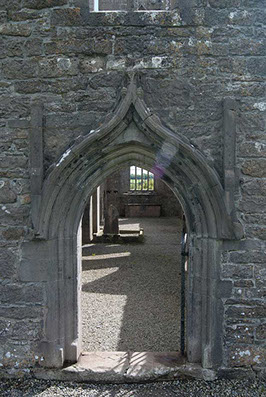 An interesting legend relating to Rosserk which is still extant in the locality tells that in the latter part of the fifth century, at the time that St. Patrick was driving the serpents out of Ireland from the top of the mountain then known by its pagan name of Cruachán Aigle, now Croagh Patrick, ‘the Sinai of Ireland,’ one of them escaped and found refuge in a hole in a great rock near the ‘Mouth of the Ford’ (present-day Ballina) in Tyrawley.
An interesting legend relating to Rosserk which is still extant in the locality tells that in the latter part of the fifth century, at the time that St. Patrick was driving the serpents out of Ireland from the top of the mountain then known by its pagan name of Cruachán Aigle, now Croagh Patrick, ‘the Sinai of Ireland,’ one of them escaped and found refuge in a hole in a great rock near the ‘Mouth of the Ford’ (present-day Ballina) in Tyrawley.
At sunset every evening the serpent was wont to light a tallow candle and anyone who saw the candle’s glow died instantly. The legend further informs us that Patrick followed the serpent and was greatly annoyed and concerned on hearing of the number of deaths caused by it-apparently the story was related to him by a widow who resided in the neighbourhood. Undaunted, at sunset, Patrick himself sallied forth and lit a candle near to the serpent’s lair, and when the serpent looked upon Patrick’s flame he fell dead, with as much speed as did his own victims. The serpent was called Seirc/Searc and the rock wherein it dwelled Carrig Seirc-‘Searc’s Rock.’
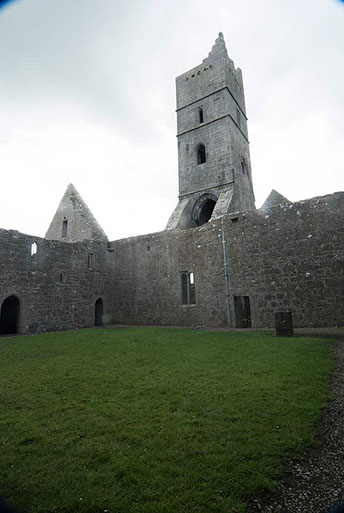 There was an oratory on the site from before the time of St. Patrick and centuries before the present monastery was built, and ‘Roseric’ is first mentioned in ecclesiastical writings c.1198. In the Ordnance Survey letters of 1838, John O’ Donovan wrote “I visited the Abbey of Rosserk not for the purpose of taking any notice of the modern Abbey but to ascertain whether or not there are any ruins of the old regles and duirteach mentioned by Mac Firbish as having been erected there for the virgin Searc, but there is not a trace of either.” A local tradition maintains that the location of Searc’s hermitage may have been nearby at Tobar Mhuire and it further implies that she may also have had a connection with the townland of Leacarrow which is south of Rosserk and where a Bronze-Age bowl and ring barrow are to be found together with some mounds and the possible site of an ancient dwelling.
There was an oratory on the site from before the time of St. Patrick and centuries before the present monastery was built, and ‘Roseric’ is first mentioned in ecclesiastical writings c.1198. In the Ordnance Survey letters of 1838, John O’ Donovan wrote “I visited the Abbey of Rosserk not for the purpose of taking any notice of the modern Abbey but to ascertain whether or not there are any ruins of the old regles and duirteach mentioned by Mac Firbish as having been erected there for the virgin Searc, but there is not a trace of either.” A local tradition maintains that the location of Searc’s hermitage may have been nearby at Tobar Mhuire and it further implies that she may also have had a connection with the townland of Leacarrow which is south of Rosserk and where a Bronze-Age bowl and ring barrow are to be found together with some mounds and the possible site of an ancient dwelling.
A certain mystery surrounds the foundation and fall of the abbey of Rosserk, ‘this mystical ruin by the sea,’ and while some writers hold that it was founded in the year 1400, other authorities would have us believe that it dates from 1441. As already referenced, it is credited to a family of Welsh extraction called Joice now Joyce, the first of whom may have been Thomas. This family have since given their name to an area lying between Lough Corrib and Lough Mask –‘Joyce Country.’ The Joyces possessed no land at Rosserk and probably acquired it by marrying into the Barrett family who held the land there.
Rosserk was built for the Franciscan Third Order or Tertiaries, a group distinct from the Franciscan First Order of Friars Minor. Apparently, the Tertiaries enjoyed widespread popularity amongst wealthy patrons in late medieval Ireland and the abbey is mentioned in 1455 as being ‘the rectory of Rosserk, formerly called the Chancellorship of Killala.’The mission of this group was education, particularly the youth, and the discharge of pastoral duties, such as celebrating the Mass and the conferring of the sacraments on the people of the region.
It is suggested that sometime during the latter part of the sixteenth century the friars of Rosserk refused to accept observant reform (28 of the 48 conventional houses adopted the observant rule) and consequently they were placed under interdict, causing them to abandon the house; it is also asserted that the proximity of the older Rosserk to the younger Abbey of Moyne supports this claim. But the visit in 1606 of the Franciscan Provincial, Donatus Mooney, to Rosserk, shows that the friars were still in occupancy at the time. So despite both being flourishing Franciscan houses, Moyne and Rosserk belonged to different branches of the order, both houses had different founders, and their closeness may just be a result of generous patronage and an abundance of vocations sufficient to support two large religious houses.
Tradition relates that the Abbeys of Rosserk and Moyne were also rivals for the lucrative salmon rights of the river Moy-‘the stream of speckled salmon’ as the ancients knew it. Stretching across Killala Bay is Bartra Island, and according to the tradition, Bartra was a peninsula on the east side of the Bay until the fifteenth century. Apparently, the monks of Rosserk were greatly aggrieved that Moyne was built two miles nearer the Mouth of the River Moy, as they had built their abbey first. So to try and gain an advantage on their brotherly rivals they cut an inlet at the East of Bartra, which steered the sought after salmon into their nets!
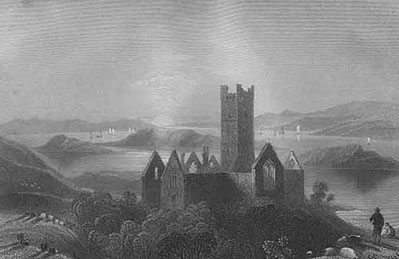 The aforementioned River Moy is celebrated in the Bardic Histories of Ireland ‘as the most fertile in fish of which the island can boast.’ On the arrival to this country of the race known to us as the Parthalonians (about 2,000 B.C.) “ they found only nine rivers in the whole kingdom and fish in this River Moy only for which reason they called it Inver Muaide which the bards interpret as Inbear Mbuaidh, the River of Virtues or Powers, from its remarkable fertility in fish.” It is also recorded that the virtuous motif relates to a women who is ‘good and noble’ so in either case the Moy is still ‘The River of Virtues.’ Rising at the foot of the romantic ‘Hill of the Fairies’ in county Sligo, the Moy pursues a sinuous course of seventy-two kilometres through ‘Old Tyrawley’-through the territories over which the O’Dowds, the O’Flaherties and others of the ancient clans of the west once held kingly sway before discharging itself by way of the Bay of Killala into the broad Atlantic.
The aforementioned River Moy is celebrated in the Bardic Histories of Ireland ‘as the most fertile in fish of which the island can boast.’ On the arrival to this country of the race known to us as the Parthalonians (about 2,000 B.C.) “ they found only nine rivers in the whole kingdom and fish in this River Moy only for which reason they called it Inver Muaide which the bards interpret as Inbear Mbuaidh, the River of Virtues or Powers, from its remarkable fertility in fish.” It is also recorded that the virtuous motif relates to a women who is ‘good and noble’ so in either case the Moy is still ‘The River of Virtues.’ Rising at the foot of the romantic ‘Hill of the Fairies’ in county Sligo, the Moy pursues a sinuous course of seventy-two kilometres through ‘Old Tyrawley’-through the territories over which the O’Dowds, the O’Flaherties and others of the ancient clans of the west once held kingly sway before discharging itself by way of the Bay of Killala into the broad Atlantic.
In any case, led by a parricide named Parthalon and often associated with the Biblical Magog, the Parthalonians, in Irish na Partholónaigh, settled in the valley of the river Liffey near Dublin and remained there for about 300 years. The demise of the Parthalonians came about when a plague descended upon them and quickly annihilated the entire colony. Their place of burial is still called in Irish Támhleacht (Támh translating as –a plague or death, leacht-monument) and is now a sprawling suburb of Dublin city-present day Tallaght.
In fact, Adamnán’s seventh-century biography of St Colm Cille mentions the Moy as Móda which came from the Celtic word in the feminine Mouda meaning ‘noble,’ ‘proud’ or ‘glorious,’ the word survived for a millennium and a half in Irish poetry, with the same meaning, and was often applied to a glorious sea-view. It is also told that it was at this “Inver-m-Buadha” that the first fishermen to arrive in Ireland put in. They were Capa, Laizne and Sluasud, and it is told that they blessed the harbour of Killala. The ninth of the old great rivers of Ireland, the mighty and sacred Moy was also blessed by Saints, Patrick, Colmcille, Bridget and Canice. Its ancient name Irish name was Sal Srota Dearg.
“There is a fine square bell tower, but no winding stairs as in Moyne. The windows and cloister show elaborate carvings and fine tracery, and testify that in those days there were Hirams ‘skilful to work in gold, in silver, in brass, in iron, in stone, in timber, in purple and blue and in fine linen, and the grave all manner of graving, and to find out every device.”
(Rev. James Greer, The Windings of the Moy)
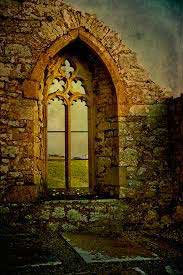 Despite the many differences in construction, Moyne and Rosserk also share some architectural features. At the time in Ireland, it was common for transepts to be added to friary churches so that the friars could accommodate their ever-growing lay congregations; they were also used to accommodate additional altars due to the huge demand for the Catholic Mass. Both Rosserk and Moyne share this identical characteristic, which would suggest that Rosserk was the model for Moyne. On the east side of side of the transept in both churches, there are two recesses set under round arches with windows to their rear. Situated between the arches in each church a secretarium may be found, while to the south of each recess there is a piscine (an area used for washing sacramental vessels). The altars would have been placed beneath the arches.
Despite the many differences in construction, Moyne and Rosserk also share some architectural features. At the time in Ireland, it was common for transepts to be added to friary churches so that the friars could accommodate their ever-growing lay congregations; they were also used to accommodate additional altars due to the huge demand for the Catholic Mass. Both Rosserk and Moyne share this identical characteristic, which would suggest that Rosserk was the model for Moyne. On the east side of side of the transept in both churches, there are two recesses set under round arches with windows to their rear. Situated between the arches in each church a secretarium may be found, while to the south of each recess there is a piscine (an area used for washing sacramental vessels). The altars would have been placed beneath the arches.
There is an old albeit unauthenticated tradition which maintains that the very first members of the Franciscan Order to set foot in Ireland came from Santiago de Compostella, in Galicia, Spain, in the year 1214. The musical sounding name, now famous all over the world, may well translate as either ‘Field of Stars,’ –Campus Stella or alternatively, Composita Tella - ‘Burial Ground.’
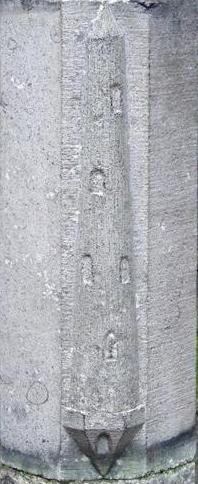 Rosserk boasts a unique high relief carving of a Round Tower-measuring about two feet in height, this particular piece of stonework is reputed to be the only medieval representation of this ubiquitous class of building.
Rosserk boasts a unique high relief carving of a Round Tower-measuring about two feet in height, this particular piece of stonework is reputed to be the only medieval representation of this ubiquitous class of building.
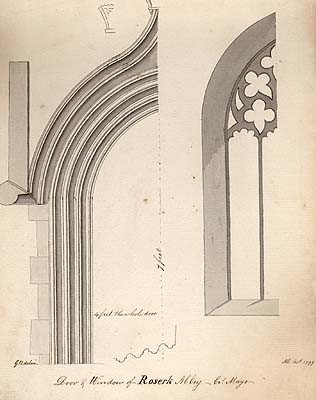 Despite the aforementioned design similarities of Moyne and Rosserk, a certain number of differences also exist between the two, differences which clearly show that Moyne was an observant house. Shunning ostentation, the observant friars fired with their rekindled desire for poverty and morality desired simplicity in all things, especially their buildings. In all friaries, the east window was always the largest and most elaborate window, but, at Moyne, the east window is of a much simpler design than the ornamented one at Rosserk. Furthermore, Rosserk boasts several pieces of decorative sculpture, including a number of carved heads, and other embellished carvings, while the observant house of Moyne is devoid of any such decoration.
Despite the aforementioned design similarities of Moyne and Rosserk, a certain number of differences also exist between the two, differences which clearly show that Moyne was an observant house. Shunning ostentation, the observant friars fired with their rekindled desire for poverty and morality desired simplicity in all things, especially their buildings. In all friaries, the east window was always the largest and most elaborate window, but, at Moyne, the east window is of a much simpler design than the ornamented one at Rosserk. Furthermore, Rosserk boasts several pieces of decorative sculpture, including a number of carved heads, and other embellished carvings, while the observant house of Moyne is devoid of any such decoration.
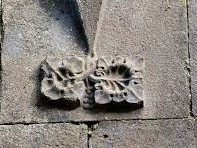
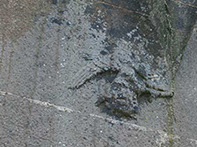 About a kilometre west of the abbey of Rosserk, in the townland of the same name, a standing stone may be viewed. According to local lore, this stone marks the southern boundary of the country of the Hy-nEthach Moy, which extended from Rosserk, northwards to Fearsad Tresi at Rathfran.
About a kilometre west of the abbey of Rosserk, in the townland of the same name, a standing stone may be viewed. According to local lore, this stone marks the southern boundary of the country of the Hy-nEthach Moy, which extended from Rosserk, northwards to Fearsad Tresi at Rathfran.
Rosserk and Moyne along with the Dominican Priory of Rathfran were sacked by Sir Richard Bingham, English Governor of Connacht, in 1590.
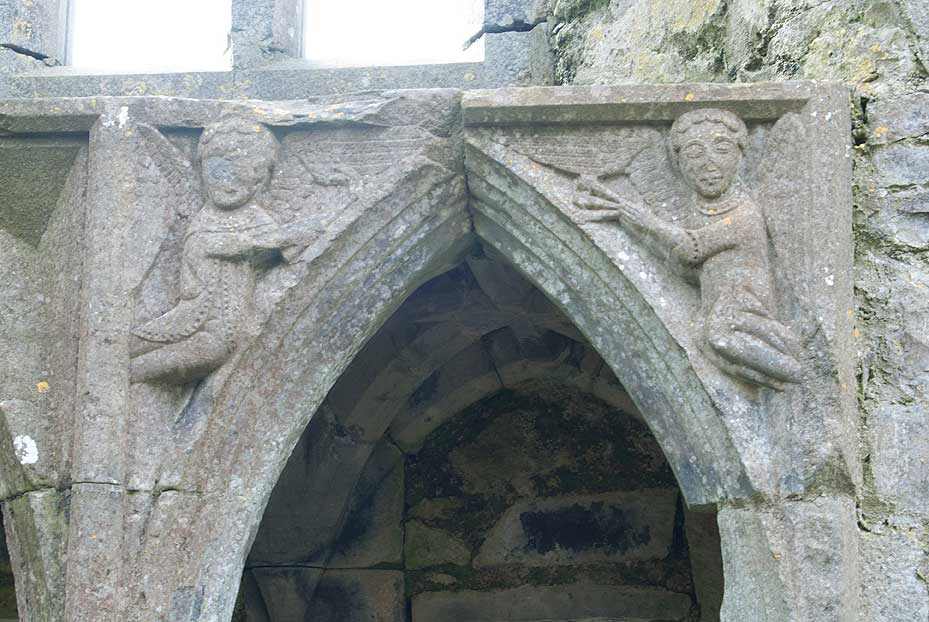
View these photos in a gallery




















